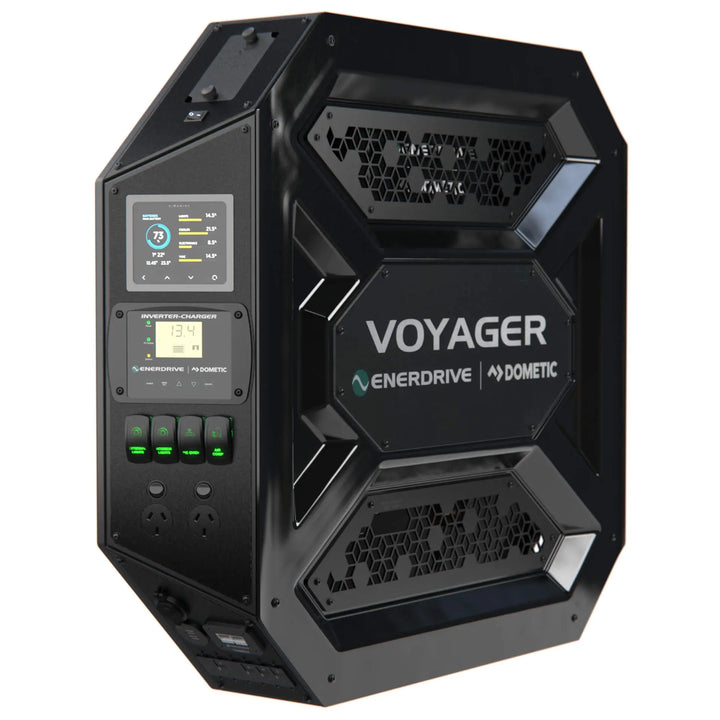You don’t buy an inverter for the idea of it; you buy one because you need 240 V where there isn’t any - at a riverside camp, on a dusty job site with power tools, in a shed with no outlets, or in a van that also has to be your kitchen and office.
Get the match right and the gear just works: fridges cycle, chargers top up, grinders spin, and laptops don’t complain.
Pure sine, modified sine, and why it matters
All inverters convert DC from a battery into AC. A pure sine wave inverter reproduces mains power with a smooth waveform, so modern electronics, variable-speed tools and induction chargers behave exactly as they’re designed to.
Modified sine wave inverters are cheaper and fine for simple resistive loads (think kettles or halogen lights), but many switch-mode supplies, CPAPs, and some brushless tools can run hot, hum, or simply refuse to start. If your kit is even slightly fussy, choose pure sine.
Some setups use an automatic inverter (often called an inverter-charger). These switch between battery and shore/generator input by themselves, charge your battery bank when external AC is present, and provide seamless power without cable-swapping. For touring vans and off-grid shacks they’re a clean, high quality solution.
How big is big enough?
Two ratings matter. Continuous watts is the power it can supply all day; surge/peak watts is the short burst to get motors moving. Many compressors, fridges, pumps, and saws need two to three times their running power for a second or two.
- Touring essentials (LED lights, camera gear, drone, phone, small laptop): 300-600 W pure sine.
- Van life / family touring (coffee machine, single-plate induction, CPAP on AC, larger laptop): 1000-1500 W with decent surge headroom.
- Tradie canopy (charger banks, shop vac, small mitre saw, SDS drill and other power tools): 2000-3000 W so start-up spikes don’t trip the unit.
- Boat or off-grid cabin (microwave, multi-outlet bench, bigger cooktops): 3000 W+ or an inverter-charger with transfer switching.
Be honest about what’s on at the same time; kettle plus coffee machine can exceed a "2000 W" nameplate in a heartbeat.
Batteries, cabling and the maths people forget
AC watts become DC amps. At 12 V, 1000 W ≈ 83 A before losses; at 24 V the current halves, which is kinder to cables. That has three consequences:
- Cable size matters. Long runs at high current need serious copper; undersized leads cause voltage drop, heat and early low-voltage cut-off.
- Fuse at the source. Use the recommended style and rating as close to the battery as practical.
- Chemistry changes behaviour. LiFePO₄ holds voltage under load and recovers fast; lead-acid sags and hates deep discharge. Sizing the inverter without sizing the battery is a trap.
If you rely on solar panels and a DC-DC charger while running loads, remember alternators don’t magically make 1500 W of usable AC on their own - the battery still does the heavy lifting when you cook or grind.
Safety and compliance in the real world
Treat 240 V like 240 V. Keep inverters dry, ventilated, and away from fumes; mount them securely; use RCD protection where appropriate. For anything beyond plug-in leads, loop in a licensed electrician - AS/NZS rules exist for a reason. A tidy system with correct earth bonding and strain relief is not optional just because it’s in a ute canopy.
Features that make life easier
Not all inverters with the same wattage are equal. Look for:
- Remote on/off or a dash switch for hidden installs.
- Adjustable low-voltage cut-off to protect the battery bank.
- Hard-wire terminals (and RCD compatibility) for permanent circuits.
- Status display or app showing load, input voltage and fault codes.
- Smart, quiet cooling - fans that ramp, not scream.
- For mixed sources, an inverter-charger with fast transfer, so the coffee machine doesn’t reset when you plug in.
Choose brands with high quality internals and real surge capability; the cheapest box that says "2000 W" can trip the first time a compressor coughs.
Picking for common Aussie scenarios
- Weekend tourer: 600-1000 W pure sine, short heavy cables to the aux battery, fused at the source, remote switch near the tailgate, and a power board for chargers.
- Serious 4WD/van: 2000-3000 W pure sine at 24 V if possible, LiFePO₄ bank, DC-DC plus solar panels, and an induction plate or coffee machine that won’t black out.
- Tradie ute: 2000 W+ pure sine with stout cabling and RCD-protected outlets in a dust-proof toolbox. Clear labelling so no one tries to run a welder off it.
- Tinnie or cruiser: Corrosion-aware mounting, drip-free location, tidy cable runs, and isolation switches where the crew can actually reach them.
A practical selection checklist
- List the actual appliances and their running and start-up demands.
- Add concurrency - what’s on together - and leave margin.
- Choose pure sine wave inverter unless you’re absolutely sure modified sine wave inverters will be fine.
- Match system voltage (12 V vs 24 V), then size cables and fusing for the current, not the wish.
- Decide whether you need an automatic inverter (inverter-charger) for shore/genny input.
- Prioritise features that reduce hassle in daily use: remote switch, RCD, clear status, quiet fans.
Still torn between 1000 W and 2000 W, or unsure if your grinder will kick over?
Tell us what you run, how you travel or work, and what batteries and solar panels you have. We'll help you pair a high quality pure-sine inverter with the right cabling and protection, so the setup behaves like a tiny mains grid - predictable, quiet and safe - whether you’re brewing at camp or cutting timber on a remote slab.









